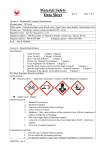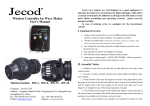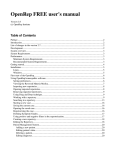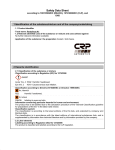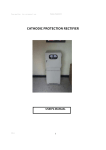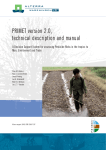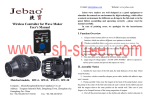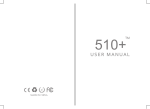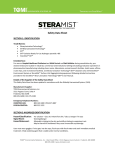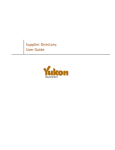Download Material Safety Data Sheet
Transcript
Material Safety Data Sheet Page 1 of 7 Section 1 - Product and Company Identification Product name DT-102 Other names -Product use -Supplier's name San Fu Chemical Co., Ltd. Supplier's address 340 Hsiao Hsin Li, Shan-Hua District, Tainan City, Taiwan, R.O.C. Supplier’s phone 886-6-5837608 Emergency phone 886-6-5837608 FAX. 886-6-5839498 Section 2 - Hazards Identification Classification 1. Flammable liquid Category 4 2. Acute toxicity Category 4 (oral) 3. Acute toxicity Category 4 (skin) 4. Acute toxicity Category 4 (inhalation) 5. Skin Corrosion/ irritation Category 1B 6. Serious eye damage/ irritation Category 1 7. Respiratory tract sensitization Category 1 8. Skin Sensitization Category 1 9. Reproductive system toxicity Category 1B 10. Specific target organ systemic toxicity – single exposure Category 1 11. Specific target organ systemic toxicity – repeated exposure Category 2 12. Hazardous to the aquatic environment (acute) Category 3 The Most Important Hazards and effect Label element Hazard symbol Health Hazards, Corrosion, Exclamation mark Signal word Danger Hazard statement: 1. Flammable liquid 2. Harmful if swallowed 3. Maybe harmful with skin contact 4. Cause severe skin burn and eye damage 5. May cause skin sensitization 6. Harmful if inhaled 7. May cause sensitization or asthma or dyspnea 8. May cause disability in 9. Harmful to the aqua livings 10. Cause organ damage (nervous system, liver) 11. Long term or repeated exposure may cause organ damage Precautionary statement 1. Having the user’s manual before operating SHS0429T4401 (Rev.3) Material Safety Data Sheet 2. 3. 4. 5. 6. 7. 8. 9. 10. 11. 12. 13. 14. 15. 16. 17. 18. 19. 20. 21. 22. 23. 24. Others Hazard -- Page 2 of 7 Understand the precautions before operating. Away from the source of the heat, sparks and open flame- strictly no smoking. Do not inhale the dust, smoke, gas, vapor spray. Wash the hands thoroughly after operation. While using this product, do not eat, drink or smoke. Operate only in outdoor or well-ventilated environment. Do not allow taking out the contaminated clothing. Avoid releasing the substance into the environment. Wear protective gloves/ clothing and wear goggles/ mask. Require respiratory protective mask if working in the bad ventilation area. Consult the doctor or drug emergency center if swallowed and felt uncomfortable. Rinse the mouth if swallowed. But do not induce vomiting. Take out the contaminated cloth immediately. Wash or shower the contaminated skin if contact with skin or hair. Move the patient into the air flesh area if inhaled. Maintain the well breathing position while resting. Wash the contaminated eye for several minutes. Take off the contact lens if possible. Seek the medical attention immediately. If causing skin sensitization or rash, seek the medical attention immediately. Cloth could be reused after wash. Practice the treatment completely. (Refer to the first aid method on the label.) Use foam, powder or CO2 to distinguish the fire. Store in the cool, well-ventilated place. Store in a place with the lock. Follow the local regulation to manage the substance and containers. Section 3 - Composition/Information on Ingredients Mixture Component or impurities contributing Concentration or concentration to the hazard range N,N-Dimethylacetamide 45~55% Ethanolamine 45~55% CAS No. 127-19-5 141-43-5 Section 4 - First Aid Measures The First-aid Information Inhalation 1. Remove the contamination or move the patient to the air fresh place. 2. Seek the medical attention immediately. Skin Contact 1. Avoid contact directly with this substance; wear the impervious gloves if possible. 2. Wash the contaminated place with gentle flowing water for at least 20 minutes. SHS0429T4401 (Rev.3) Material Safety Data Sheet Page 3 of 7 3. 4. 5. Remove contaminated clothing, shoes, and leather product during flushing. Seek the medical attention immediately. Wash the contaminated clothing, shoes, and leather product before reuse or dispose. Eye Contact 1. In case of contact, immediately flush eyes with gentle water for at least 30 minutes till the contamination is removed. Keep eyelid apart and away from eyeballs during irrigation. 2. Avoid the sewage touch the unaffected eye. 3. Seek the medical attention immediately. Ingestion 1. Do not induce vomiting. 2. Provide large amount of water. (if possible, provide the active carbon paste) 3. If the patient loss of consciousness or cramp, don’t give any food. 4. Seek the medical attention immediately. The Most Important Symptoms and Hazardous Effects -Protection of First-aiders 1. Do not practice Mouth-to-mouth resuscitation. 2. Wear category C protective equipments to avoid contact with this substance. Notes to a Physician Active carbon paste preparation method: mix well with the active carbon 50g and water 400ml(about 2 cups) Section 5 - Fire Fighting Measures Extinguishing Media foam, chemical powder, CO2 Specific Hazards when Fire-fight Evacuate the staff into the safety area Specific Fire-fighting Procedure: -Specific Protection of Firefighters Fireman must wear full chemical protective clothing and air breathing apparatus. (wear aluminum mirage protecting coat if necessary) Section 6 - Accidental Release Measures Personal Precautions Wear proper protective equipments Environmental Precautions 1. Process aeration in the area before the cleaning in the indoor area. 2. Do not empty into the rivers to cause .the affection of the environments Methods for Cleaning up 1. Plugging. 2. Use inert material to absorb the substance (sand, plastic acidic binder, general binder, sawing wood powder) 3. Evacuate the personnel from the contaminated area to safety place and processing the separation. Restrict access the area. 4. The cleaning staff should wear Positive Pressure Self-Contained Breathing Apparatus and anti hazardous clothing. 5. Cut off the source of the leakage if possible. 6. Avoid empty into the limited space such like sewer, drainage etc. SHS0429T4401 (Rev.3) Material Safety Data Sheet Page 4 of 7 Section 7 - Handling and Storage Handling 1. Avoid inhale this substance. 2. Avoid contact with skin, eyes, and cloth. 3. Wash the hand immediately before taking a rest and after operating this substance. 4. Wash the contaminated clothing before reuse. 5. Operate in the confined area and fully ventilated. 6. Operators must undergo the professional training and strictly follow the operating procedure. 7. Away from the source of the fire and heat. Strictly no smoking in the working area. 8. Avoid leaking of the vapor into the airborne of the working area. 9. Precaution during transport. Avoid damage in container and packaging. 10. Should have the leaking emergency equipments and appropriated Fire Equipments. Storage 1. Store in the cool, well ventilation room. 2. Tightly sealed the container. 3. Should have appropriated Fire Equipments. 4. Should have the leaking emergency equipments and appropriated collecting material in the storage area. Section 8 - Exposure Controls & Personal Protection Engineering measures 1. Install proper ventilation equipments for aeration. 2. Install the emergency showering and eye washer equipments. Control parameters TWA STEL Ceiling Biological standards ---N N Dimethyl Acetamide 10ppm skin 36mg/m3 Ethanolamine 6 ppm 3ppm 7.5mg/m3 Personal protective equipment Respiratory Protection If the vapor is generated, required compound air purifying respirator. Hand Protection Wear rubber gloves. Eye Protection Wear chemical protective goggles and anti splash mask. Skin and Body Protection Wear protective clothing with the characteristics mentioned above and rubber boots. Hygiene measures 1. Remove contaminated clothes, clean thoroughly before reuse or disposal. Must advise the danger to the laundry worker. 2. Smoking, eating and drinking are prohibited in work area. 3. Wash hands thoroughly after handing this substance. 4. Maintain a clean working environment. SHS0429T4401 (Rev.3) Material Safety Data Sheet Section 9 - Physical & Chemical Properties Appearance orange yellow, red liquid Odor ammonia smell Olfactory threshold: Melting Point: -- -- Page 5 of 7 pH value acidic Boiling point/boiling range Flammability: -- Flash point 78°C Test method closed cup Decomposition temp Auto ignition temp > 350 °C > 350 °C Explosion properties -- -- Vapor pressure -- Vapor density -- Density 0.966(25°C) Solubility fully water soluble log Kow Evaporation Rate 50~75% -- Section 10 - Stability & Reactivity Data Stability Stable in the normal condition. Possible hazardous reactions under specific conditions Conditions to avoid >350 °C Materials to avoid -Hazardous decomposition products -- No reaction. Section 11 - Toxicological Information Route of exposure Skin, inhalation, ingestion, eyes Symptoms Irritation, nausea, vomit, stomachache, convulsion, coma, skin sensitization. Immediate Toxicity 1. Skin Cause skin irritation. 2. Inhalation No info. 3. Eye Cause eye irritation 4. Ingestion Cause headache, nausea, vomit, gastrointestinal tract irritation, convulsion, coma. LD50: 3000~6000 mg/kg (rat oral) (N N Dimethyl Acetamide) LD50: 2240~9600 mg/kg (rat skin) (N N Dimethyl Acetamide) LC50: 2.2 mg/L (rat inhalation) (N N Dimethyl Acetamide) LD50: 1515~3320 mg/kg (rat oral) (2-Ethanolamine) LD50: 1025 mg/kg (rat skin) (2-Ethanolamine) LC50: -- mg/L (rat inhalation) (2-Ethanolamine) Specific effects Repeated dose through oral pathological change: abnormal reduction of the red blood cells in stomach, testicle , liver and kidney.(Anemia) Repeated dose through inhalation Affected in kidney, liver and damage of retinal. SHS0429T4401 (Rev.3) Material Safety Data Sheet Section 12 - Ecological Information Ecotoxicology LC50(fish) 1. Semi-lethal concentration (LC50) 96 h Fathead minnow 1,500 mg N Acetamide 2. Semi-lethal concentration ( LC50) 96 h > 150 mg 2-Ethanolamine EC50(Aquatic Invertebrates) - Bioconcentration factor (BCF) -Persistence and degradability - Half-Life (Air) - Half-Life (Water surface) - Half-Life (Groundwater) - Half-Life (Soil) -Bioaccumulative potential -Mobility in soil -Other adverse effects -- Page 6 of 7 N-Dimethyl Section 13 - Disposal Considerations Methods of disposal 1. Dispose the empty containers; the attachment of the inboard container must be totally eliminated. 2. To entrust the accredited waste disposal industry. Section 14 - MSDS Transport Information UN classification number 3625 Proper D.O.T Shipping Name Corrosive liquid, acidic, organic, n.o.s. Hazard Class 8 Packing Group III Marine pollution none Specific precautionary transport measures and conditions -- Section 15 - Regulatory Information Regulations 1. Regulations for Labor Safety and Health Installations 2. Regulations for Chemical Hazard Communication 3. Permissible Exposure Limits of Hazardous Substances in the Work Environment 4. Road Traffic Safety Regulations 5. Industrial Waste Storage and Disposal Regulations and Facility Standards 6. Public Hazardous Materials and Flammable Pressurized Gases Establishment Standards and Safety Control Regulations SHS0429T4401 (Rev.3) Material Safety Data Sheet Page 7 of 7 Section 16 - Other Information Literature MSDS from manufacturer database references Suppler San Fu Chemical Co., Ltd. Address 340 Hsiao Hsin Li, Shan-Hua District, Tainan City, Taiwan, R.O.C. Prepared by Supplier’s phone 886-6-5837608 FAX. 886-6-5839498 Name Chunfel Chang Revision 3 Issue date 2012/9/1 Symbols Explanations: Remarks “--” No information is available at this time. “/” Not applicable to this substance. This information above has consulted national or international papers and manufacturer or supplier’s provided information. The above information is believed to be correct but does not purport to be all inclusive and shall be used only as a guide. Users should make their own determination of the suitability of the information for their particular purposes. SHS0429T4401 (Rev.3)







